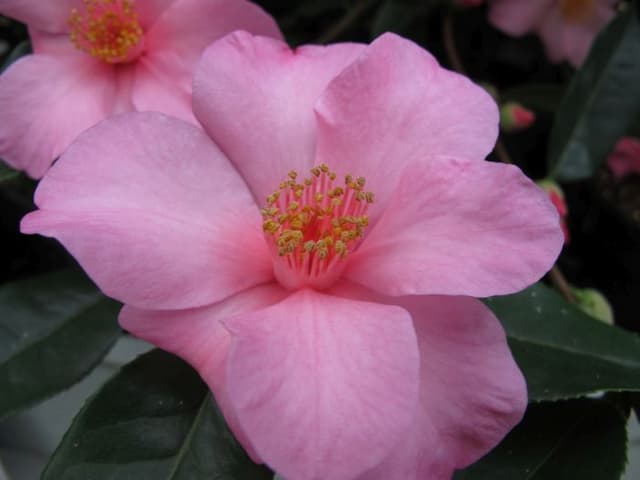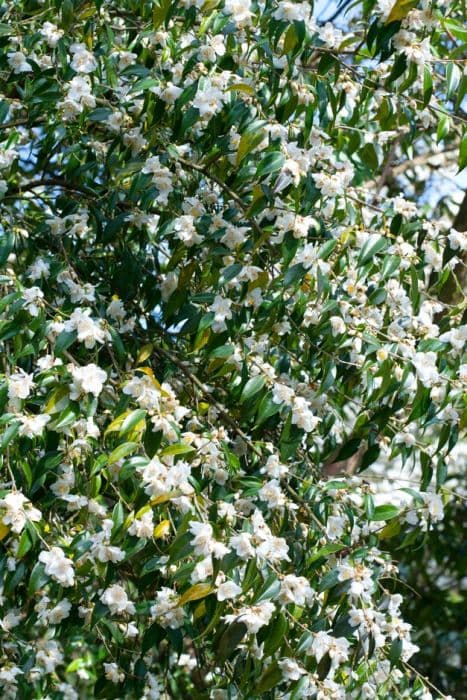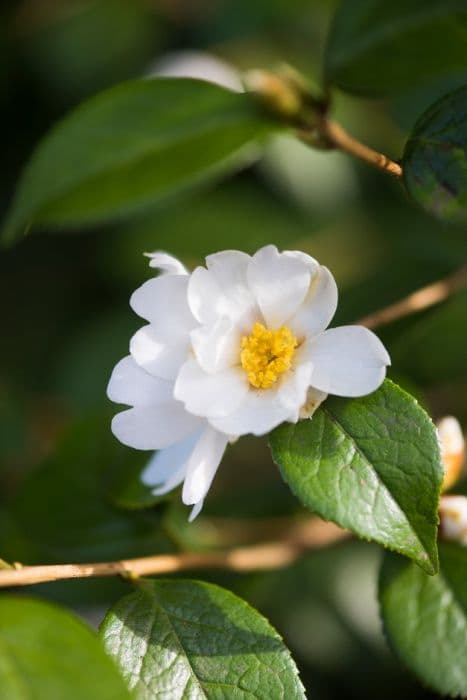Jury's Yellow Camellia Camellia × williamsii 'Jury's Yellow'

ABOUT
Camellia 'Jury's Yellow' is an evergreen shrub that is known for its lush, glossy green foliage and attractive flowers. The leaves are oval-shaped and have a leathery texture, serving as a dark green backdrop for the showy blooms. The standout feature of this plant is its flowers, distinct with creamy-yellow centers surrounded by petals that range from pale ivory to soft pink. These flowers are formal double blooms, which means they have multiple rows of petals that are neatly arranged, creating a very symmetrical and sophisticated appearance. The blooms have a ruffled look and dense texture and are often described as resembling small peonies or roses. The creamy-yellow heart of the flowers adds a touch of warmth and uniqueness, making this plant a coveted specimen for gardens where it can offer year-round interest with its evergreen leaves and seasonal blooms.
About this plant
 Names
NamesFamily
Theaceae
Synonyms
Williamsii Camellia, Jury's Yellow Camellia
Common names
Camellia × williamsii 'Jury's Yellow'.
 Toxicity
ToxicityTo humans
Williamsii Camellia is not considered toxic to humans. Consequently, ingestion of parts of this plant typically does not lead to poisoning or serious adverse health effects.
To pets
Williamsii Camellia is generally considered non-toxic to pets as well. It is not known to cause poisoning if pets happen to ingest parts of the plant. Therefore, pet owners usually don't have to worry about serious health consequences if their animals come into contact with or consume this plant.
 Characteristics
CharacteristicsLife cycle
Perennials
Foliage type
Evergreen
Color of leaves
Dark green
Flower color
Pale yellow
Height
6-10 feet (1.8-3 meters)
Spread
6-10 feet (1.8-3 meters)
Plant type
Shrub
Hardiness zones
7-9
Native area
Asia
Benefits
 General Benefits
General Benefits- Aesthetic Appeal: Camellia 'Jury's Yellow' has attractive, pale yellow flowers that add beauty and a unique color variation to gardens.
- Year-Round Interest: Evergreen foliage provides visual interest throughout all seasons, maintaining a lush appearance even when not in bloom.
- Landscape Versatility: This plant can be used in a variety of garden designs, including formal, Asian-inspired, or woodland settings.
- Privacy Screen: With its dense growth habit, it can serve as an effective privacy screen or hedge when planted in a row.
- Shade Tolerance: Capable of thriving in partial shade, it offers a flowering option for garden spots that receive limited sunlight.
- Low Maintenance: Once established, it requires minimal care beyond occasional pruning and watering during dry periods.
- Pollinator Friendly: The flowers provide a nectar source for bees and other pollinating insects in the garden.
- Long Blooming Period: It boasts a longer blooming period compared to many other camellias, extending the display of flowers.
- Winter Blooming: As it typically flowers from late winter into spring, it adds color to the garden at a time when few other plants bloom.
- Cold Resistance: It is relatively hardy and can withstand occasional cold snaps in temperate climates, making it suitable for a range of locations.
- Gifting Plant: Due to its beauty and low maintenance, it makes an excellent gift for garden enthusiasts and plant lovers.
- Soil Adaptability: Adaptable to a range of soil types, though it prefers well-draining, acidic soil for optimal growth.
 Medical Properties
Medical PropertiesThis plant is not used for medical purposes.
 Air-purifying Qualities
Air-purifying QualitiesThis plant is not specifically known for air purifying qualities.
 Other Uses
Other Uses- Art and Craft Projects: The petals of Camellia 'Jury's Yellow' can be used in crafting, such as pressing for bookmarks or including in resin jewelry for an aesthetic touch.
- Photography Subject: Due to its unique color and form, 'Jury's Yellow' is an excellent subject for botanical photography, useful in portfolios and art exhibitions.
- Teaching Tool: In horticultural classes, Camellia 'Jury's Yellow' can be used to teach plant hybridization and the impact of selective breeding on plant traits.
- Wedding Decor: The soft yellow blossoms can complement wedding bouquets or serve as gentle accents in table centerpieces.
- Dyeing Fabric: The petals might be boiled to extract a light yellow dye for natural fabric dyeing projects.
- Homemade Potpourri: Dried petals of 'Jury's Yellow' can be added to potpourri mixes for a subtle fragrance and visual variety.
- Culinary Garnish: Although not commonly known for their taste, the petals can be used as an edible garnish for salads or desserts for a touch of elegance.
- Floral Arrangements: The blooms can be used in live floral arrangements in homes and public spaces, offering a soft pop of color and texture.
- Botanical Art: The leaves and blooms can be used in botanical prints or to create delicate pressed flower art pieces.
- Symbolic Gifts: As symbols of admiration and perfection, the flowers of Camellia 'Jury's Yellow' can be given as gifts to convey respect and well wishes.
Interesting Facts
 Feng Shui
Feng ShuiThe Camellia is not used in Feng Shui practice.
 Zodiac Sign Compitability
Zodiac Sign CompitabilityThe Camellia is not used in astrology practice.
 Plant Symbolism
Plant Symbolism- Admiration: Camellias are often associated with deep admiration for someone, making them perfect to express praise and positive feelings towards another person.
- Perfection: As a flower with lush, perfectly arranged petals, the Camellia symbolizes the ideal or pursuit of perfection.
- Long-lasting devotion: The Camellia's enduring nature represents long-lasting or eternal devotion between individuals, thus commonly given as a sign of loyalty.
- Affection: The warmth of the Camellia's appearance can express genuine affection and warmth towards a loved one.
- Gratitude: A Camellia flower can symbolize gratitude, and 'Jury's Yellow' with its unique color might be chosen to show appreciation with a flair of uniqueness or personal touch.
 Water
WaterJury's Yellow camellias require consistent soil moisture but should not be left in soggy conditions. They should be watered once a week with about 1.5 gallons of water per session, though this amount can vary depending on soil type and climate. During hot, dry periods, watering frequency may need to increase to maintain soil moisture. It's important to water deeply to encourage root growth. Reduce watering in the winter when the plant is not actively growing.
 Light
LightThe best light condition for Jury's Yellow camellias is partial shade with filtered sunlight. They thrive under the canopy of tall trees that provide dappled sunlight, as direct afternoon sun can lead to leaf scorch. Morning sunlight with afternoon shade is ideal for promoting healthy growth and flower production.
 Temperature
TemperatureJury's Yellow camellias do best in temperatures ranging from 50 to 80 degrees Fahrenheit. They can tolerate minimum temperatures of around 20 degrees Fahrenheit, but prolonged exposure to temperatures below this can be harmful. To ensure the health of the plant, avoid placing it in locations where temperature fluctuations are common, such as near air conditioning vents or heaters.
 Pruning
PruningPrune Jury's Yellow camellias to maintain shape and promote bushier growth, and to remove any dead or weak branches. The best time to prune is after they have finished blooming in late winter or early spring. Pruning can be done annually, but avoid cutting into old wood as camellias can be slow to recover from heavy pruning.
 Cleaning
CleaningAs needed
 Soil
SoilThe best soil mix for Camellia × williamsii 'Judy's Yellow', commonly known as Jury's Yellow Camellia, is well-draining, rich in organic matter with a slightly acidic pH between 5.5 and 6.5. A mix of equal parts of peat moss, pine bark, and perlite or coarse sand is ideal.
 Repotting
RepottingJury's Yellow Camellia should be repotted every 2 to 3 years, in the spring, before the growing season starts, to refresh the soil and provide room for further growth.
 Humidity & Misting
Humidity & MistingJury's Yellow Camellia thrives best in conditions with high humidity, generally around 50-60%. Maintaining this level will support the plant's overall health and bloom production.
 Suitable locations
Suitable locationsIndoor
Place Jury's Yellow Camellia in bright, indirect light and maintain high humidity.
Outdoor
Plant Jury's Yellow Camellia in partial shade with shelter from strong winds.
Hardiness zone
7-9 USDA
 Life cycle
Life cycleCamellia × williamsii 'Jury's Yellow', commonly known as Camellia, begins its life cycle when a seed germinates, typically in a moist, well-drained soil environment with partial shade. The seedling then develops into a juvenile plant, marked by a period of rapid vegetative growth where it establishes a root system and foliage. As the plant matures, it enters a flowering stage, which for Camellia 'Jury's Yellow' typically occurs in late winter to early spring, producing creamy-yellow flowers that attract pollinators for sexual reproduction. Following pollination, the flowers develop into seed-containing fruits, completing the reproductive phase. The plant then enters a period of growth maintenance, focusing on strengthening and expanding its vegetative parts to ensure survival and future flowering. Over the years, the Camellia 'Jury's Yellow' will experience cycles of growth, flowering, and dormancy, potentially living for several decades with proper care and ideal growing conditions.
 Propogation
PropogationPropogation time
Early spring
Camellia × williamsii 'Jury's Yellow', commonly known as Jury's Yellow Camellia, is most commonly propagated through semi-hardwood cuttings. The best time for taking cuttings is in late summer when the plant's new growth has begun to mature. Begin by selecting healthy, disease-free stems that have new growth. Cut a 4 to 6-inch (approximately 10 to 15 cm) length, ensuring that at least two sets of leaves remain on the cutting. Remove the bottom leaves and dip the cut end into a rooting hormone to encourage root development. Plant the cutting in a well-draining potting mix and keep it in a warm, humid spot out of direct sunlight. Covering the pot with a plastic bag can help retain moisture, but be sure to open it occasionally to prevent mold. With proper care, the cutting should develop roots within several weeks to a few months, after which it can be gradually acclimated to standard growing conditions and eventually transplanted outside.









